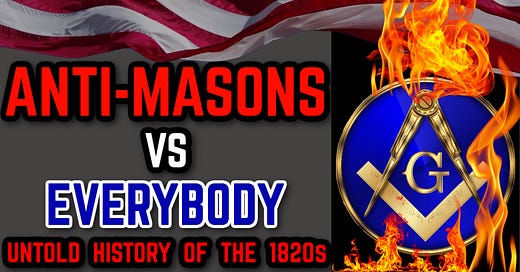The Anti-Masonic Party vs Everybody: Untold History of the 1820s Part 1
Did you know there was a third political party that quickly spread across the US called the Anti-Masonic Party? I guess history book printers must have ran out of ink on this chapter?
ANTI-MASONS vs EVERYBODY
The Anti-Masonic Party made it clear; they are neither Republican nor Democrat, they are a new party who saw the bigger picture. In fact, they took it a step further by speaking out against both sides of the two-party system. Anyone who was a Mason, or supporting the Masons, needed to be removed from power.
In the summer of 1828, the brotherhood held a large convention to recruit new Masons in Genesee county, but only a few months later, when the people again cast their votes, nearly 100% voted for the new Anti-Masonic party. This was a massive problem for the Masons because, at the time, it was reported that members of the secret society held “about two-thirds of the offices of trust, profit and honor in the general and state governments”, and these positions had not been previously contested by any serious candidate who had the support of the people. …The war had officially begun...
During this same timeframe, the subject of the People forming the Anti-Masonic party in the state of New York had spread to Pennsylvania. Pennsylvanians were elated so they went to work establishing a newspaper to spread the word of the movement and expose the principles of the fraternity.
In Michigan, many counties began seeing support for Anti-Masonry (Washtenaw, Wayne, Oakland, Monroe, Macomb, St. Clair, St. Joseph’s, Lenawee and more). The movement even made it’s way to our upper peninsula. The next election resulted in the nomination of Anti-Masonic Judge John Biddle.
In February of 1829, a State convention was held in Albany, New York in which representatives from 42 counties were present; Republicans, Democrats and Anti-Masons. It was at this convention that the Anti-Masons tried to get both the Republicans and Democrat representatives to condemn Masonry, yet none would openly declare themselves in opposition to the brotherhood. The new political party openly questioning State representative about their “caressing” of Freemasons made the politicians very nervous.
After the convention, the politician’s anxiety turned to rage. The Republicans and Democrats sought to destroy the Anti-Masons. The incumbent of the executive chair assumed the duties of his office with bitter hatred toward Anti-Masonry. Interestingly, this man of power was previously a judge who, at that time, lead the Anti-Masons to believe that he rallied behind their movement, even calling it “a blessed spirit” and describing it as the same spirit “which had called this nation into existence”, stating Anti-Masonry “was a pledge that our rights and liberties are destined to endure”. “From that period, the influence and patronage of the general and state governments have been directed with all their force against Anti-Masonry. With few exceptions, the leading politicians of all parties, united to suppress the rising spirit of inquiry”, wrote Mr. Seward, a member of the Anti-Masonic Party Committee.
The press was wielded as a weapon, both to suppress speech and to run psychological warfare campaigns against the people, condemning the Anti-Masonic party meanwhile boosting support for the Republican and Democrat candidates. The newspapers, now knowing the citizens disliked Freemasonry, created fake stories about the favored politicians battling the brotherhood. They raved about the successes the two-party-system members had in slowly dismantling the fraternity. They told the public the Masons were on the run, its organization was dying and it was only a matter of time until it is completely defeated… the problem was, no such battles ever occurred. The Republicans and Democrats still refused denounced Freemasonry, so the press did it for them.
The Anti-Mason movement of “emancipation from the thraldom of secret societies” was quickly spreading across the state of New York. This lead to the New York supporters of Anti-Masonry publishing their own content, Truth content. Their content made its way out of the state, sparking a mass Awakening.
THE ELECTIONS
Despite the media propaganda, come spring, town meetings were overflowing with Anti-Masons. The fall elections proved that Anti-Masonry had taken deep root in society; the people were not detoured by fake news. The outcome of the next election was Honorable Albert H. Tracy from New York being elected to the Senate by a majority of 8,000 votes. Additionally, 30 Anti-Masonic members were elected to the House of Assembly. Even Honorable Hermer Denny, who ran in Pittsburg, a Freemason hotbed, became a member of Congress, winning by over 1,000 votes. In the end, Anti-Masonry received record shattering vote totals and the “infected areas” gained ground, thus extending their Anti-Masonic boarders from the Niagara river on the west to the Cayuga Lake on the East and from Lake Ontario on the North to Pennsylvania on the South.
While all of this was going on, the media was telling the public that the Freemason political candidates had no competition and would easily win in a landslide victory, however, at the next State Convention, only 12 total representatives showed up. Joseph Ritner, an Anti-Masonic candidate for Governor, raked in 52,000 votes, thus overthrowing the Freemason candidate, Mr. Wolf. Joseph Ritner would become Governor of Pennsylvania.
In Massachusetts, Anti-Masonry first appeared in Bristol county. The support was so strong that “the delegation to the senate of the state was wholly Anti-Masonic and elected expressly on Anti-Masonic principles”. This lead to the creation of the Boston Free Press, a vigorous supporter of Anti-Masonry.
New Jersey citizens began opposing secret societies and also started working toward getting candidates in office.
In Connecticut, where only two newspapers were exposing the Freemasons while 28 were under the control of the fraternity, six Anti-Masonic senators and around one-fourth of the house of representees in this state won their elections.
Anti-Masonry had now spread to Vermont. In the counties of Orange and Caledonia, town meetings began discussing the new movement. Vermont citizens wasted no time in supporting the new third party. A state convention was assembled and an Anti-Masonic candidate was nominated for governor. Although this candidate won by 7,300 votes, he declined the job. A second state convention was held in Vermont which, amongst other victories, resulted in the election of General Cahoone to Congress.
In Ohio, Anti-Masonic candidates in the general election prevailed in Northern parts of the state (Adams, Knox, Tuscarawas, Harrison, Wayne, Richland, Huron, Portage, Geauga, Ashtabula and more). Some counties of Ohio reported having considerable strength, boasting 40,000 supporters of the movement.
Rhode Island, a state overran by Freemasons, came on board and immediately established a press. The state would quickly become the strongest supporter of Anti-Masonry in the Union.
As of 1830, in Maryland, Delaware, Indiana and surprisingly, even Alabama, the Anti-Masonic party was beginning to appear.
Within only a few years, many more Anti-Masons would be elected to Congress as well as other positions, including:
Massachusetts
William Jackson, Congress
John Reed Jr., Congress
New York
William Babcock, Congress
Gamaliel H. Barstow, Congress
Timothy Childs, Congress
John A. Collier, Congress
Bates Cooke, Congress
John Dickson, Congress
Philo C. Fuller, Congress
Gideon Hard, Congress
Abner Hazeltine, Congress
George W. Lay, Congress
Henry C. Martindale, Congress
Robert S. Rose, Congress
Phineas L. Tracy, Congress
Grattan H. Wheeler, Congress
Frederick Whittlesey, Congress
Millard Fillmore, New York State Assembly (1829–1831)
William H. Seward, New York State Senate (1831–1834)
Ohio
Jonathan Sloane, Congress
Pennsylvania
Robert Allison, Congress
John Banks, Congress
Charles Augustus Barnitz, Congress
Richard Biddle, Congress
George Chambers, Congress
William Clark, Congress
Edward Darlington, Congress
Edward Davies, Congress
Harmar Denny, Congress
John Edwards, Congress
Thomas Henry, Congress
William Hiester, Congress
Francis James, Congress
Thomas McKean, Congress
Charles Ogle, Congress
David Potts Jr., Congress
Andrew Stewart, Congress
Joseph Ritner, Governor of Pennsylvania (1835–1839)
Thaddeus Stevens, Pennsylvania House of Representatives (1833–1835)
Rhode Island
Dutee Jerauld Pearce, Congress
William Sprague III, Speaker of the Rhode Island House of Representatives (1832–1835)
Vermont
William Cahoon, Congress
Benjamin F. Deming, Congress
Henry Fisk Janes, Congress
William Slade, Congress
Silas H. Jennison, Governor of Vermont (1835–1841)
Lebbeus Egerton, Lieutenant Governor of Vermont (1831–1835)
William A. Palmer, Governor of Vermont (1831–1835)
Augustine Clarke, Vermont State Treasurer (1833–1837)
Allen Wardner, Vermont State Treasurer (1837–1838)
Go paid at the $5 a month level, and we will send you both the PDF and e-Pub versions of “Government” - The Biggest Scam in History… Exposed! and a coupon code for 10% off anything in the Government-Scam.com/Store.
Go paid at the $50 a year level, and we will send you a free paperback edition of Etienne’s book “Government” - The Biggest Scam in History… Exposed! OR a 64GB Liberator flash drive if you live in the US. If you are international, we will give you a $10 credit towards shipping if you agree to pay the remainder.
Support us at the $250 Founding Member Level and get a signed high-resolution hardcover of “Government” + Liberator flash drive + Larken Rose’s The Most Dangerous Superstition + Art of Liberty Foundation Stickers delivered anywhere in the world. Our only option for signed copies besides catching Etienne @ an event.






